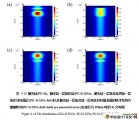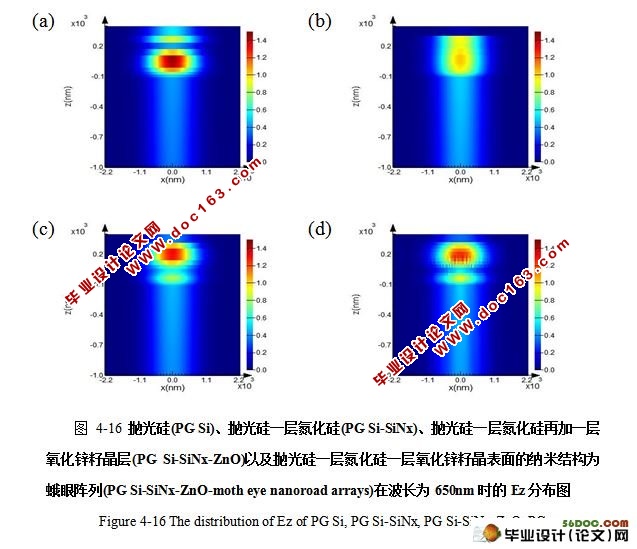太阳能电池减反膜的数值模拟

太阳能电池减反膜的数值模拟(含任务书,开题报告,外文翻译,毕业论文14000字,答辩PPT)
中文摘要
太阳能电池的减反射技术能大大提高电池的光电转换效率,因此一直备受关注。减反射技术多种多样,目的都是为了得到更低的反射率和更高的透过率。最近几年,对纳米陷光结构的研究甚是火热。本文主要利用有限时域差分方法(FDTD),从最基本的抛光硅片出发探索各种陷光措施的实际效果,有减反射薄膜技术、表面制绒织构化技术、表面纳米陷光技术(ZnO阵列),同时也进行了不同技术之间的对比。研究发现:SiNx薄膜的减反增透效果明显,且优化的双层SiNx效果更佳;制绒确实大大降低了硅片的反射率,而且合理设计金字塔之间的间距可以进一步提高抗反射能力;纳米阵列的反射率受实际填充率和最小周期性单元的尺度的影响。对于纳米陷光结构最关键的一点是:低的反射率不一定会拥有高的透过率,结构本身对光存在吸收,因此合理协调结构从而使电池效率最佳是我们正真应该关注的问题。本次研究发现,经过优化的蛾眼状ZnO纳米阵列的平均反射率和平均透过率均达到最佳状态,此时结构几何参数为:高度为200nm,底面直径为50nm,间距为0nm时。此时:反射率(最低):8.0185%,透过率(最高):87.9598%。
关键词: 减反射、SiNx薄膜、制绒、陷光、ZnO纳米阵列、平均反射率、平均透过率
[资料来源:www.doc163.com]
Abstract
Because of antireflective technology can greatly improve the photoelectric conversion efficiency of the solar cell, it has been a concern. All kinds of antireflective technology are aimed at obtaining lower reflectance and higher transmittance. Recent years, the nanotechnology in the field of light trapping is very hot. In this paper, the finite-difference-time-domain ( FDTD ) is used to find the most desired structure. The study starting from the most basic structure: polishing silicon to explore the actual effect of some kings of light-trapping technique, including: SiNx film technology, surface texturing technology, nanotechnology ( the ZnO nanorod arrays ), and the contrast between the different technologies. Study found the antireflection effect of single-layered SiNx:H films is obvious, and the double-layered SiNx film is better. Surface texturing technology indeed greatly reduces the reflectivity of the wafer, and well control the distance between the pyramids can further improve antireflective ability. The reflectivity of nano arrays changes with fill rate and the unit scale of minimum periodic. For nano light trapping structure the most crucial point is: the low reflectivity may or may not have a high transmittance of light , nano-structure itself have a certain light absorption, reasonable coordination structures so that the battery at its best is which should be concerned. The study found that after the optimization moth-eye shape ZnO nanorod arrays obtain the best reflectance and transmittance. Its reflectivity and transmittance are 8.0185% , 87.9598% respectively. The geometry parameters is as follow:
Height: 200nm
Ground diameter: 50nm
Distance: 0nm .
key words: Antireflection、Silicon nitride film、Texturing 、Light trapping 、ZnO nanorod arrays、The average reflectivity、The average transmittance
研究目的
本次实验研究了硅基太阳能电池表面各种的减反射技术,包括单层、双层SiNx减反射涂层、制绒、表面纳米陷光结构,主要利用FDTD方法,选择波段350nm-1050nm进行计算机模拟实验。首先,探究减反射涂层的减反射效果和增透作用。其次,研究制绒对抗反射的贡献,并初步探索了制绒所得金字塔之间间距对减反射的影响。最后,模拟了各种ZnO纳米陷光结构,主要考察了不同的形貌和尺度(高度、间距、大小)的纳米阵列的减反射能力,进行对比得到最佳的ZnO纳米减反射阵列。
1.4、论文结构
论文是组织结构如下:
第一章:调研了太阳能电池减反射的发展历史,查看了当下国外和国内热门的减反射技术,并给出本次研究的目的。
第二章:简单介绍减反射原理和一些进行模拟时必备的光学参数。
第三章:阐述了FDFD(有限时域差分方法)的原理和进行模拟的一般过程。
第四章:展示数值模拟内容与模拟结果,并对所得结果进行了分析和讨论。 [资料来源:http://www.doc163.com]
第五章:对本次研究进行总结概括,展望太阳能电池减反射技术的未来。

目录
中文摘要 I
关键词 I
Abstract I
key words II
1 引言 1
1.1、研究起因 1
1.2、太阳能电池减发射研究综述 1
1.3、研究目的 7
1.4、论文结构 7
2 减反射原理及光学参数 7
2.1、减反射膜的基本原理 7
2.2、光学参数 8
3 FDTD数值计算算法和程序设计 9
3.1、FDTD简介 9
3.2、稳定性条件 14
3.3、数值计算的基本过程 14
4 微、纳减反射模型的数值模拟 14
4.1、模拟参数的设置以及误差分析 14
[来源:http://www.doc163.com]
4.2、微米级模型 15
4.3、纳米级模型 16
4.4、微、纳数值模拟 18
5 结论与展望 33
参考文献 34
致谢 37
[版权所有:http://DOC163.com]
